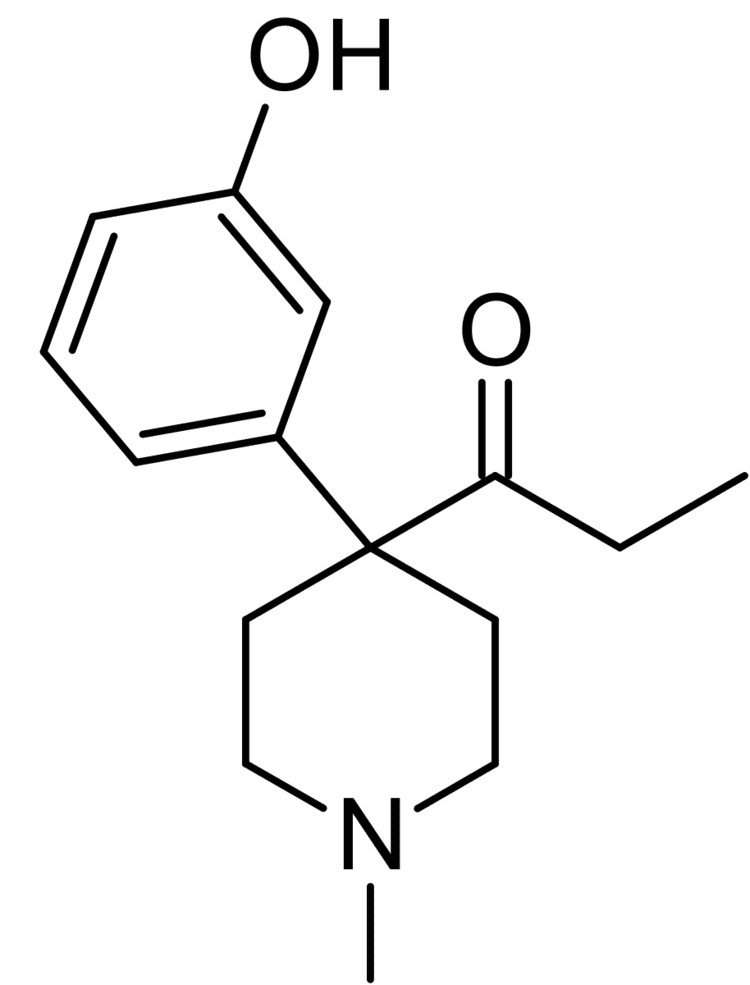ATC code N02AB01 (WHO) | Biological half-life 2-4 hours | |
 | ||
AHFS/Drugs.com International Drug Names Legal status AU: S9 (Prohibited)CA: Schedule IDE: Anlage II (Prohibited)US: Schedule I Bioavailability 34% (oral), 44% (rectal) | ||
Ketobemidone (trade names Cliradon, Ketogan, Ketodur, Cymidon, Ketorax, and others) is a powerful opioid analgesic. Its effectiveness against pain is in the same range as morphine, and it also has some NMDA-antagonist properties imparted by its metabolite norketobemidone. This makes it useful for some types of pain that don't respond well to other opioids. The most commonly cited equalisation ratio for analgesic doses is 25 mg of oral ketobemidone hydrobromide to 60 mg of morphine hydrochloride or sulphate and about 8 mg of ketobemidone by injection and 10 mg of morphine.
Contents
The UN reported shortly after the beginning of marketing of ketobemidone that it was "nine times more active" than methadone, presumably as a euphoriant, and was thus labelled as extra-dangerous along with dextromoramide ("three times more active than heroin") and several other synthetics about the same time, as expanded upon below.
It is used for all types of severe pain, such as postoperative, cancer, kidney stones and fractures.
History
Ketobemidone was first synthesized in 1942 by Eisleb and colleagues, at the laboratory of I.G. Farbenindustrie at Hoechst during the Second World War. The first study of it in humans was published in 1946, and it was introduced in clinical medicine shortly after. It was not in clinical use in the United States when the Controlled Substances Act 1970 was promulgated and was assigned to Schedule I with an ACSCN of 9628. As of 2013, no annual manufacturing quota was assigned by the DEA.
Pfizer manufactures ketobemidone under the tradenames Ketogan and Ketorax. It is available as tablets, suppositories, and injection fluid. A sustained release formulation exists, sold as Ketodur, in some countries containing 10 or 25 mg ketobemidone.
Pharmacology
Experiments on former addicts indicated it was more addictive than other opioids, so in 1954 the Economic and Social Council took a resolution urging governments to stop manufacture and use of ketobemidone. This result was not in agreement with clinical observations, and another study in 1958 did not find it more addictive than morphine. That study noticed that while for morphine the dose for euphoria is the same as that for analgesia, for ketobemidone the analgesic dose was well below the euphoric dose. Ketobemidone is mostly used in the Scandinavian countries, with Denmark topping the statistics.
Analgesia after 5-10 mg orally or 5-7.5 mg intravenously lasts 3–5 hours. Ketobemidone is also available in preparations with a spasmolytic, which can improve the analgesia.
Metabolism
Ketobemidone is mainly metabolized by conjugation of the phenolic hydroxyl group, and by N-demethylation. Only about 13-24% is excreted unchanged after intravenous administration.
Chemistry
Ketobemidone is 1-methyl-4-(3-hydroxyphenyl)-4-propionylpiperidine. It is usually available as the hydrochloride, which is a white powder. It is synthesized by alkylating (3-methoxyphenyl)acetonitrile with bis(2-chloroethyl)methylamine, followed by reaction with ethylmagnesiumbromide, and finally O-demethylation with hydrobromic acid.
Because of a strong vesicant nature of bis(2-chloroethyl)methylamine there are many other routes developed for obtaining ketobemidone. A route depicted below lays through first alkylating the same (3-methoxyphenyl)acetonitrile with 2-chloro-N,N-dimethylethylamine or 2-chloro-N-benzyl-N-methylethylamine. Next, those amines are alkylated once again using a mixed 1-bromo-2-chloroethane, thus completing the piperidine ring and obtaining a quaternary ammonium salt, which can be dequaternized using thiophenol salt (for N,N-dimethylammonium) or catalytic hydrogenation (for both compounds) to a common 4-(3-methoxyphenyl)-4-cyano-1-methyl-pyperidine. The later yields ketobemidone after Grignard reaction with ethylmagnesium bromide and ether cleavage.
